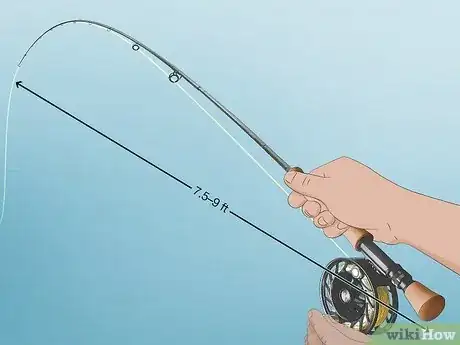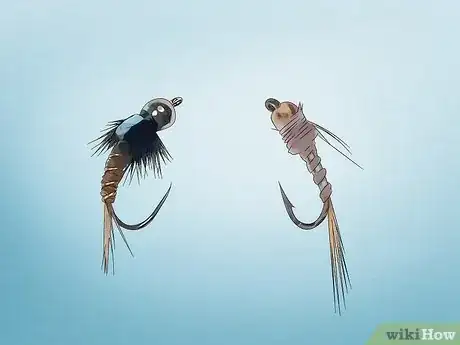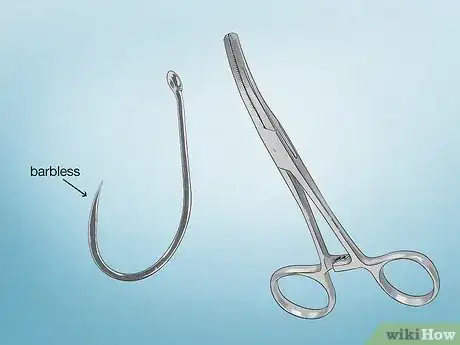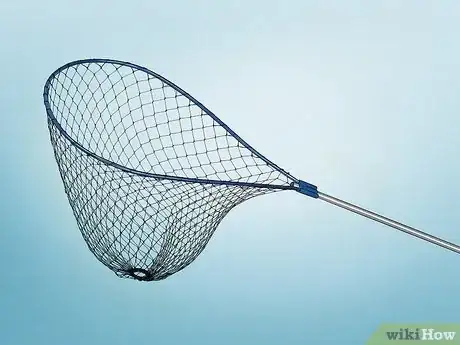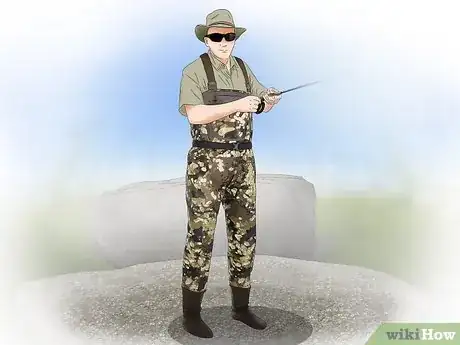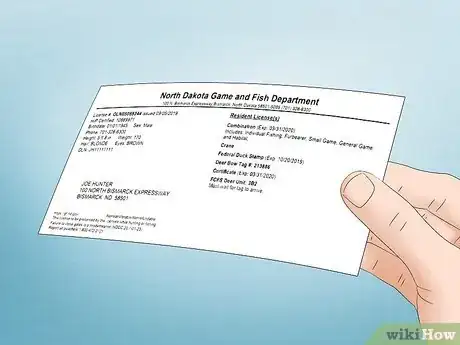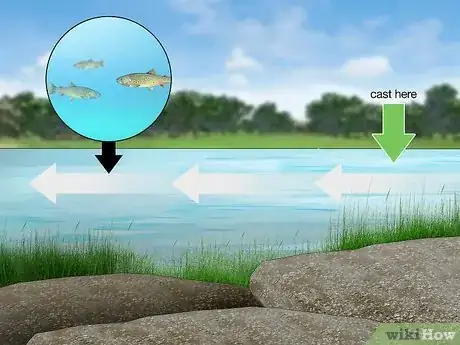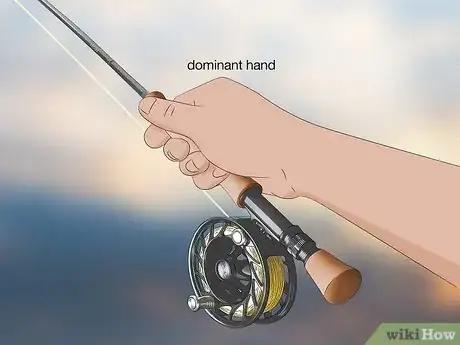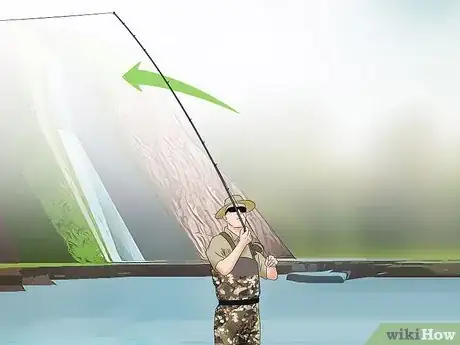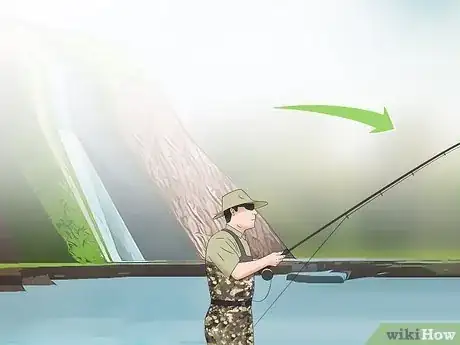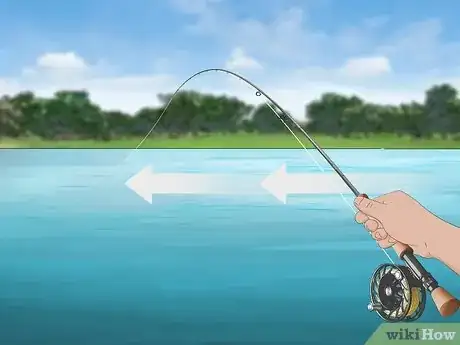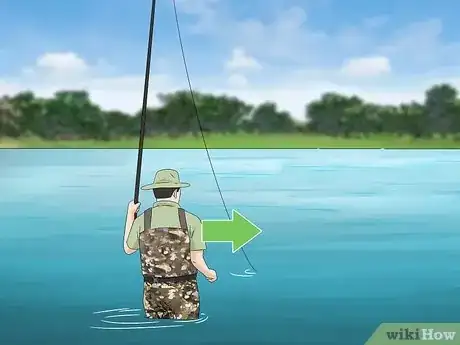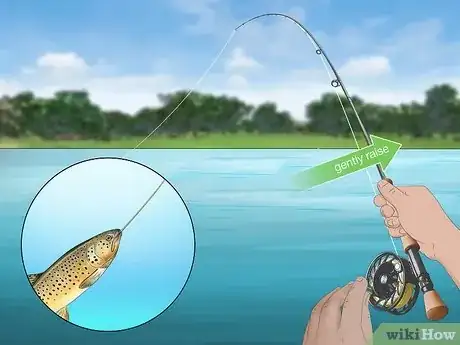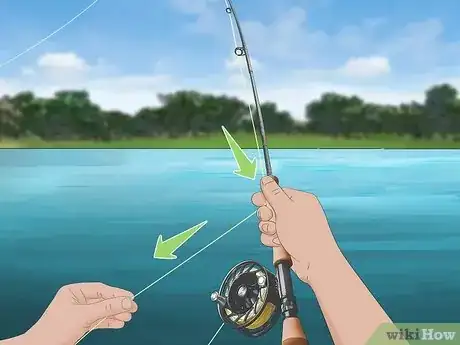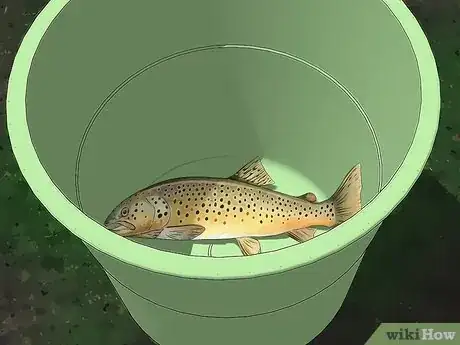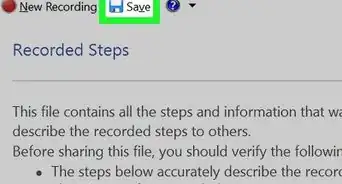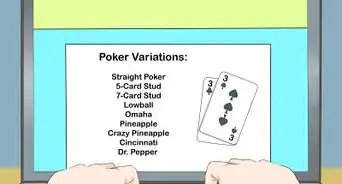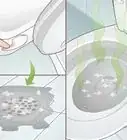This article was co-authored by Kathy Sparrow, MA and by wikiHow staff writer, Madeleine Criglow. Kathy Sparrow is a fly-fishing instructor and adventurer at heart. Kathy is the co-founder and previous manager of the Kingfisher Inn, a fly-fishing lodge on the Lower Laguna Madre in Texas. She is the author of "On the Mother Lagoon: Flyfishing and the Spiritual Journey" and "The Whispered Teachings of Grandmother Trout” a novel conveying the feminine perspective of fly fishing. Kathy is also a Certified Canfield Trainer in Canfield Methodologies. She guides individuals through the process of embracing change by expressing confidence, awareness, and courage through the tools of writing, fly fishing, and intentional conversation. She has a MA in English with an emphasis in Literature and Cultural Studies from the University of Texas-Pan American.
There are 19 references cited in this article, which can be found at the bottom of the page.
This article has been viewed 1,865 times.
Are you ready for the trout fishing adventure of a lifetime? Fly fishing is a challenging and fulfilling sport that offers you the chance to get out into nature, hone your fishing skills, and catch some tasty trout. If you're a beginner, this article is here to help you every step of the way. We'll cover all the gear you need, the best fishing spots for trout, and most importantly, how to master the perfect cast.
Steps
The Best Fly Fishing Gear for Trout
-
1Set up your fly fishing pole and reel. Rent or purchase a fly fishing pole that's between 7.5–9 ft (2.3–2.7 m) in height.[1] Though pole weights can vary, go for a 5-weight pole as a safe bet.[2] To make sure your rod and reel are balanced, pair that with a 5-weight or 6-weight disc drag fly reel. For the perfect setup, use 5-weight fly line to match the weight of your fishing pole and run it through each guide of the pole so that the fly line is properly secured.
- A 7.5–9 ft (2.3–2.7 m) rod is a little bit longer than a standard rod, which is perfect for making a good fly fishing cast.
- A disc drag fly reel is stronger than other reels and great for larger fish like trout.
-
2Choose a terrestrial fly or a wet fly to attract trout. The fly is the bait you use to draw trout to your line. Since terrestrial insects, drowned insects, and small fish are a big part of a trout's diet, terrestrial flies and wet flies (nymphs and streamers) are the perfect bait. Purchase these at a fishing supply store in your area or online.[3]
- A fly fishing fly mimics insects that float above or just below the water and baitfish (small fish that swim below the water's surface).
- If you'd rather use live bait, look up the restrictions in your area first on your local government's website. In the United States, for example, using live bait is illegal in Oregon and prohibited in fresh water in Alaska.[4]
- For even more advice, talk to an employee at a fishing supply store and ask what they would recommend for the area you're fishing in. They'll use their experience and preferences to give you specialized tips.
Advertisement -
3Opt for a size 8, barbed hook if you're keeping the trout. A size 8 is a medium-weight hook, which is perfect for the weight of a trout. If you're new to fishing, go for a single-point, barbed hook. These are strong enough to take hold of the trout, while also being easier to dislodge. Alternatively, go for a treble hook if you'd like to ensure that you keep your catch. Just make sure that they're legal in your area first.[5]
- Visit your local government's website to look up the restrictions on keeping fish. Some areas prohibit treble hooks, and others won't let you keep trout of a certain size or less.[6]
-
4Bring a barbless hook and a hemostat if you plan on releasing the fish. Catching and releasing is a fun way to fish and conserve the fish population, too. To make sure your hook protects the fish from injury, opt for a barbless hook. These are missing the extra V-shaped point at the end of the hook, which prevents the fish from being injured when they're caught. Remember to bring a hemostat as well (a tool that helps you safely unhook a fish to release it again).[7]
- If you don't have a hemostat, you can also use needle-nose pliers.
-
5Bring a net to catch your trout. Even if you don't plan on keeping the trout, a net can help you safely catch the fish, take a picture, and release it back into the wild. For the best results, choose a mesh net with a short handle that's less than 20 inches (51 cm). As for net size, a 10 in (25 cm) by 18 in (46 cm) hoop will be plenty of room for a good size trout.[8]
-
6Wear protective, camouflage gear meant for fly fishing. This includes waders, wading boots, a fly fishing vest, a hat, and polarized sunglasses. If it's cold or rainy, you'll benefit from wearing long underwear, thermal socks, and raingear. To make sure that you blend in with your environment, make sure all of your clothes are in a camouflage pattern or in muted colors.[9]
- Bright colors might catch a trout's attention and scare them away, and that also goes for a bright flight.
-
7Get a fishing license that corresponds to where you're fishing. The requirements vary depending on where you are, but in the United States, all states require you to buy a fishing license. To purchase a license, visit the website of the Department of Fish and Wildlife in your area or locate a local vendor on the website and buy one in person. Once you get your license, print it and keep it with you while you're fishing so that you can present it to a ranger at any time![10]
- The average cost of a fishing license is $25.42 for residents and $61.52 for non-residents.[11]
- If you're caught fishing without a license, you may be subject to a ticket and some pretty hefty fines.
The Best Spots and Times of Day to Catch Trout
-
1Choose a cold, freshwater river, stream, or lake. Trout thrive in these environments as the cold water allows them to hold oxygen. They're also able to find the food they need to survive, since baitfish and aquatic insects are found in rivers and streams as well. To find a particular location, visit your local government's website or consult a fishing map that covers your region. Both will offer more info on the best fishing zones in your area.[12]
- Opt for a creek or stream if this is your first-time fly fishing. A smaller area can be a little easier when you're first starting out, and there will hopefully be fewer people around compared to a larger river setting.
-
2Find trout in areas with rich vegetation and deeper waters. Trout rely on underwater vegetation, fallen logs, and rock piles for protection and shelter. To increase your chances, seek out areas with lots of trees, shade, and vegetation along the bank of the water. For an even better shot, seek out deeper waters. These areas are often much cooler, which trout prefer (particularly in the summertime).[13]
- If you're fishing in a lake, try fishing near the inlets (where the river or stream flows into the lake). Trout like these areas, as they're cooler and offer a steady source of food.[14]
-
3Plan to fish in the early morning for the best results. Trout prefer feeding in cool to moderate water temperatures, so it's easier to catch them when the sun isn't fully out. For a scenic and successful fly fishing trip, get out in the water at dawn and fish as the sun rises.[15]
- If you're fishing in the midday, opt for a location with plenty of shade cover or take your trip on an overcast day. This will help keep the water temperature cool throughout the day, which encourages trout to keep feeding.
Casting Your Line
-
1Cast upstream and against the current. Casting your line directly above a trout may scare it away (trout are easily spooked). To avoid scaring them, cast your line upstream from the fish and against the current.[16] This will allow your line to float downstream towards the trout, which is called a dead drift.
-
2Grasp your rod firmly with your thumb on top of the grip. A firm hold on the rod is important so that you can exert enough strength for a strong cast. Make sure to hold the rod in your dominant hand so that you have more control over your cast as well.[17]
-
3Raise your rod straight up above you and guide it backward. This is the first motion of an overhead cast. Holding the rod straight so that it points to the air, guide it backward until it reaches slightly behind your shoulder. Then, pause for a few seconds to let the fishing line unfurl.[18]
- Always check behind you before doing an overhead cast to make sure there aren't any people or low-hanging branches in the way.
- Make sure you don't rush when fly fishing. Always have patience and don't try to cast too fast.
-
4Push the rod forward and stop it to cast the line. After pausing with the rod held slightly behind your shoulder, bring it forward in the upstream direction. Then, stop the rod in a forceful motion to give your cast enough force. This motion will cast your line upstream, allowing the bait to land on top of the water and begin to float.[19]
-
5Keep an eye on your bait as it floats downstream. Now that you've completed your upstream cast, allow your bait to drift downstream toward the trout. While you wait, avoid any sudden movements or noises and keep a watchful eye on your bait. That way, you won't miss any fish taking hold.[20]
-
6Move or change your fly if you aren't getting any fish. Though how long you wait is up to your personal preference (fishing can be a waiting game), try changing your fly if you aren't getting any bites. Reel in your line and try a fly in a different size, color, or shape that might be more enticing to the trout. You might also consider moving to a new location. If you can, try to find one in the area with a different depth of water (deeper or more shallow than where you are).[21]
Catching, Releasing, and Storing the Trout
-
1Tighten your fishing line as soon as a trout takes hold of the bait. If you feel your line moving or feel something tugging at the fishing line, it's very likely a fish is biting at your bait.[22] As soon you feel a bite, gently raise your fishing rod just enough to tighten the fishing line (avoiding sudden or jerking movements that may scare the trout). To hold the line tight, press your fingers against the fishing line so that it's held against the fishing rod.
-
2Lure the fish towards you by stripping the line. Once the trout has taken hold of your bait, it's time to pull the line towards you with your fingers. This is called a strip set. Do this in a gentle and steady motion, pulling the fish toward you to make your catch.[23]
- If your fish tries to swim away, pull the line in the opposite direction with your fingers to give the line more slack. This will prevent the fish from breaking your fishing line. Then, strip the line in like before to pull the trout closer.
- Repeat this motion until the fish becomes tired and stops fighting.
- Though it may be tempting, avoid jerking your rod in a stark, upward motion to catch the fish. This could put tension on your rod and even break it if you aren't careful.
-
3Guide the fish toward shallow water and into your fishing net. Once the trout is tired out and stops fighting, strip the line toward shallower water. Then, use the hand that's not holding the rod to pull out your fishing net. Guide the trout over the brim of the net to make your catch. If you plan on releasing the fish, make sure to keep the trout fully submerged in the water as you guide it into the net (10 seconds out of the water or more can be enough to kill a trout).[24]
- If you're just starting out, asking a fishing buddy to hold the net can make this process a lot easier.
-
4Unhook the trout using a hemostat if you want to release it. If you don't want to keep your trout, use your hemostat to clamp onto the hook and gently dislodge it from their mouth. As you unhook the trout, keep their body submerged in water so that they don't lose their slimy, protective coat in the dry air. To further protect the fish, wet your hands before handling the fish.[25]
-
5Be extra speedy if you want to take a photo before releasing the trout. Again, a trout can't survive out of the water for much longer than 10 seconds. If you want to take a photo with your catch, ask your fishing partner to have their camera ready before you take it out of the water. Then, pose for your photo with the trout just above the water. That way, you can submerge it back into the water as soon as you've captured the moment on camera.[26]
-
6Release the trout in the direction of the current. Submerging your hands in the water, hold the trout's body with your hands using a loose grip. Then, point its face towards the direction of the current. Once you notice the trout attempting to swim away with the current, allow the fish to swim away with the current.[27]
- It may take a few seconds to a full minute for a fish to revive itself and swim away after being caught.
-
7Kill the trout and store it in a cooler if you want to keep it. If you plan on cleaning and gutting the trout to eat, unhook the trout and kill it as soon as possible. To ensure that it doesn't suffer, knock out the trout first by laying its body on a flat surface and hitting the top of its head with a club.[28] Then, pierce through its brain with a knife to kill the fish. After, store the fish in an insulated cooler with cold water and ice.
- If you don't have a club, any blunt object will do.
- Avoid killing the trout by letting it asphyxiate in the air. This causes an unnecessary amount of suffering, as it can take several seconds for a trout to lose consciousness and die.
- Though it's best to gut the trout as soon as you get home, trout can be stored in the fridge for up to 2 days before spoiling.[29]
Warnings
- Check the fishing rules and regulations in your area ahead of time. Look up your local government's website to find information on fish size restrictions and other ecological guidelines.[30]⧼thumbs_response⧽
References
- ↑ https://www.dec.ny.gov/outdoor/62477.html
- ↑ https://www.nps.gov/articles/fly-fishing.htm
- ↑ https://www.iowadnr.gov/fishing/fishing-tips-how-tos/how-to-fish-for-/trout-fishing
- ↑ https://strikeandcatch.com/is-fishing-with-live-bait-illegal/
- ↑ https://www.bestfishinginamerica.com/how-to-trout-fishing-basics-how-to-catch-techniques-tips.html
- ↑ https://www.dec.ny.gov/outdoor/50859.html
- ↑ https://myodfw.com/articles/how-fish-trout
- ↑ https://flylordsmag.com/gear-essentials-how-to-choose-the-right-net/
- ↑ https://www.dec.ny.gov/outdoor/62477.html
- ↑ https://crowsurvival.com/caught-without-a-fishing-license/
- ↑ https://hookedinfishing.com/fishing-license-cost-by-state/
- ↑ https://vtfishandwildlife.com/about-us/department-divisions/fish-division/fish-management/wild-trout-management/what-is-good-trout-habitat
- ↑ https://www.iowadnr.gov/fishing/fishing-tips-how-tos/how-to-fish-for-/trout-fishing
- ↑ https://myodfw.com/articles/how-fish-trout
- ↑ https://www.takemefishing.org/freshwater-fishing/when-to-freshwater-fish/best-time-to-fish-trout/
- ↑ https://www.dec.ny.gov/outdoor/62477.html
- ↑ https://wetflyswing.com/how-to-cast-a-fly-rod/
- ↑ https://www.takemefishing.org/how-to-fish/how-to-catch-fish/how-to-cast-fly-rod/
- ↑ https://www.takemefishing.org/how-to-fish/how-to-catch-fish/how-to-cast-fly-rod/
- ↑ https://www.dec.ny.gov/outdoor/62477.html
- ↑ https://www.takemefishing.org/blog/july-2015/7-tricks-to-try-on-a-fishing-trip-when-the-fish-wo/
- ↑ https://hookedinfishing.com/learn-to-fish/how-to-catch-fish/detecting-fish-bites/
- ↑ https://www.nps.gov/articles/fly-fishing.htm
- ↑ https://www.wildtrout.org/content/catch-and-release
- ↑ https://myodfw.com/articles/how-fish-trout
- ↑ https://www.wildtrout.org/content/catch-and-release
- ↑ https://myodfw.com/articles/how-fish-trout
- ↑ https://www.compassioninfoodbusiness.com/media/7434844/humane-slaughter-rainbow-trout.pdf
- ↑ https://www.takemefishing.org/how-to-fish/how-to-catch-fish/how-to-store-fish/
- ↑ https://www.dec.ny.gov/outdoor/50859.html
